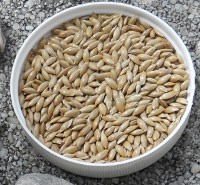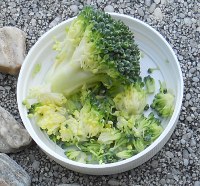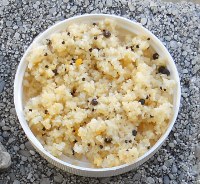Food Digest
Contributions, research and write up by Israel. Page is a work in progress.
Birds consume a variety of seeds and greens, and there are many options for nesting/rearing foods. What follows is a look into the various foods that have been mentioned in the bird pages above, and a look at some of the options for nesting and rearing foods. For a list of what individual seeds are contained in the Topflite seed mixes look at this link.
Seed
|
Canary SeedThe staple seed of the canary & budgie diet, Canary seed is grown by Topflite locally in North Otago. Canary seed comes from Canary Grass (Phalaris canariensis), native to the Mediterranean, and is a tough crop.
|
|
Rape SeedA favourite of canaries, rape seed (Brassica napus, a member of the mustard/cabbage family) is high in fat. A low erucic acid and low glucosinolate version and is also harvested for oil (Canola Oil). As it is high in fact it should make up only a small portion of a bird seed mix, and is usually found as a component of soft food mixes, the additional fat content being useful during rearing and molting seasons.
|
|
LinseedAlso known as flax seed (Linum usitatissimum), linseed in rich in protein and oils, and when fed during molt can help in the maintain of good quality plumage for the birds. Linseed can usually be found in small amounts in seed mixes, and contains omega-3 fatty acids. Linseed is aso used commercially to produce oil.
|
|
MilletA staple seed for finch seed mixes, millet is very high in carbohydrates. The seed dish to the left is a millet mix, containing Panicum, Red Panicum, and White French Millett. Millet is imported into NZ from Australia.
|
|
Sunflower SeedThe 'fruit' of the sunflower (Helianthus annuus) the seed is a component of cockatiel and parrot mixes in its whole seed for (as in the picture). In its hulled form, especially when chopped as well, it can be feed to other birds including canaries, who will quite happily devour the seed. As it is very high in fat (another seed that is used to produce oil) it should be feed in moderation. It is ruch in Vitamin E. Sunflower is grown in NZ.
|
|
WheatA component of pigeon, aviary and parrot mixes, Wheat (Genus - Triticum) is a common grain with many different varieties that is used as a worldwide staple for the production of bread and pasta amongst many other things. It is a very hard grain.
|
|
OatsOats (Avena sativa) is a common grain that is used in both human foods (as oatmeal and rolled oats) and livestock consumption. It is very high in carbohydrates making it a good energy food, and is suitable in its harder grain state for harder billed birds (such as budgies and larger birds).
|
|
Radish SeedRadish seeds are acquired when raddishes (Raphanus sativus) are left to grow past their usually harvesting stage, and grow in pods. They are a spicy seed. |
* For the nutritional information above, Very Low is considered <=5%, Low 6-10%, Average 11-35%, High 36-50%, Very High >=50%. All categories are approximate.
Greens
|
BroccoliBroccoli (Brassica oleracea) is a favourite of canaries in particular, and is an excellent source of many vitamins (A, B, C in particular), proteins, fibre and calcium. Can be served chopped or whole and the leaves are also good for the birds. Broccoli is highly recommended. |
|
CarrotCarrot (Daucus carota) is an excellent source of Vitamin A, K and C, and contains beta-carotene which helps brighten and enhance the colour of canaries (yellow canaries go a brighter yellow, and red-factors go an orange colour) so it is an essential food during the molt. Carrot is best served to birds grated, or mixed in with other rearing foods. Carrot greens can also be fed. Carrot is highly recommended, but it can take a while for the birds to get used to the food. |
|
AppleApples (Malus domestica) are high in water, making them a good treat food during the warmer weather, and a gopod molt food. With some many varieties, birds may like some more than others, but in general they are readily devoured by most birds, though they do need to be sliced for the birds. The seeds should be removed, as they are not good for birds. Apples are also high in soluble fibre. |
|
Salad GreensCommercially available Salad Greens are a mixture of Asian & European Brassicas, Lettuces, Endives and Spinach. Overall, they make a good treat food, and are readily accepted. Spinach should be feed sparingly as it has high levels of oxalic acid, but in general salad greens are a good source of some vitamins, moisture and fibre. Iceberg lettuce should be avoided as it is little more than fibre and water, and can cause diarrhea in birds if too much is fed. |
Rearing Foods
See also the articles Talking Soft Food and What to put in? - A look at soft food from a budgie and canary perspective.
|
Soft FoodCommercially available soft food is essentially a mixture of bread crumbs, rape seed, and sometimes some egg powder, though different companies manufacture different styles/ranges. Soft food makes a good base for nesting foods, but needs to be mixed with water before being feed by itself to birds. There are numerous recipes for homemade softfood as well, with bases of crumbed bread or crushed wine biscuits, vitamins, seed and other additions added on top. On a small scale, commercial soft food works fine, and should be fed all year round to maintain familiarity, but in larger operations it becomes unpractical and expensive. |
|
Egg FoodAs hatchlings go through a period of rapid growth they need a good source of protein. The best is (chicken) eggs, but their use in breeding is only applicable for small scale operations. The egg food shown here is a mix of the above commercial soft food and a hard boiled egg (boiled for 15 minutes, so that all bacteria have been killed), combined in a food processor and mixed for about 5 seconds till it is a moist crumbly mixture. It can be chilled and served out over the course of a day, but will not keep much longer than that. |
|
Chick Starter CrumbleChick starter crumbles are used as a component of rearing foods by a number of our members. As it comes in large bags, it is usually best to group buy. For more information on the recipes that it is used in see the soft food article in Monty's Corner. |
Minerals
|
CuttleboneCuttlebone is used as a source of calcium, and can be brought from supermarkets or pet stores. While Zebra Finches will readily devour it, other birds will pay it a lot less attention. When in doubt over whether your birds, will use it some cuttlebone should be provided, along with other sources of calcium, which is important for both gone growth, feather growth and the creation of eggs. |
|
Crushed Oyster ShellCrushed Oyster Shell has two main uses - as a source of calcium, and as grit for a birds. There is a lot of opinions over whether captive birds require grit or not, as most of the seeds they consume are already hulled and hence don't need the grit to help break them down, but if provided birds will consume it and thrown it around. Either way, it is still a good source of calcium! |
















